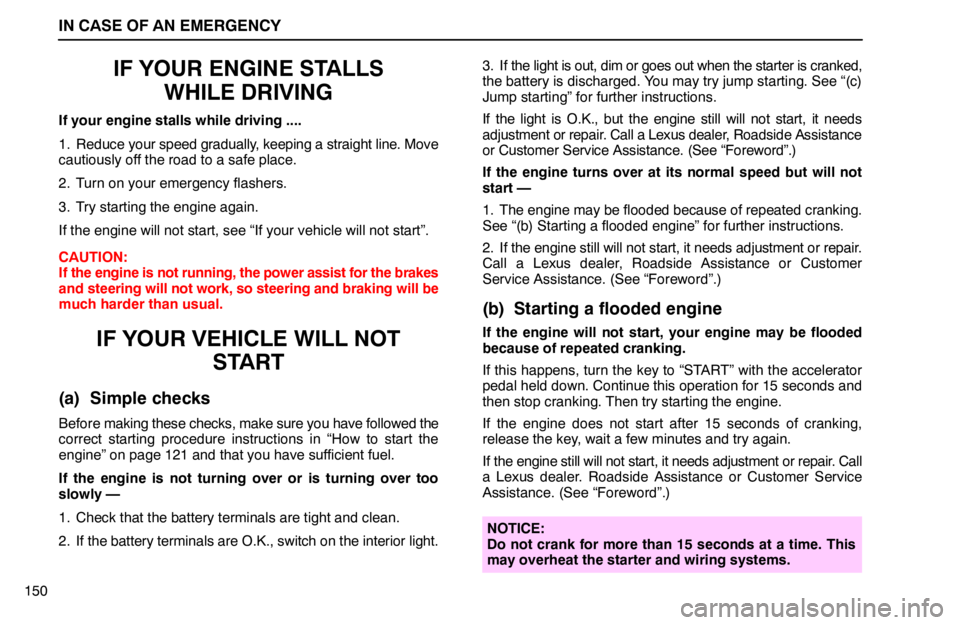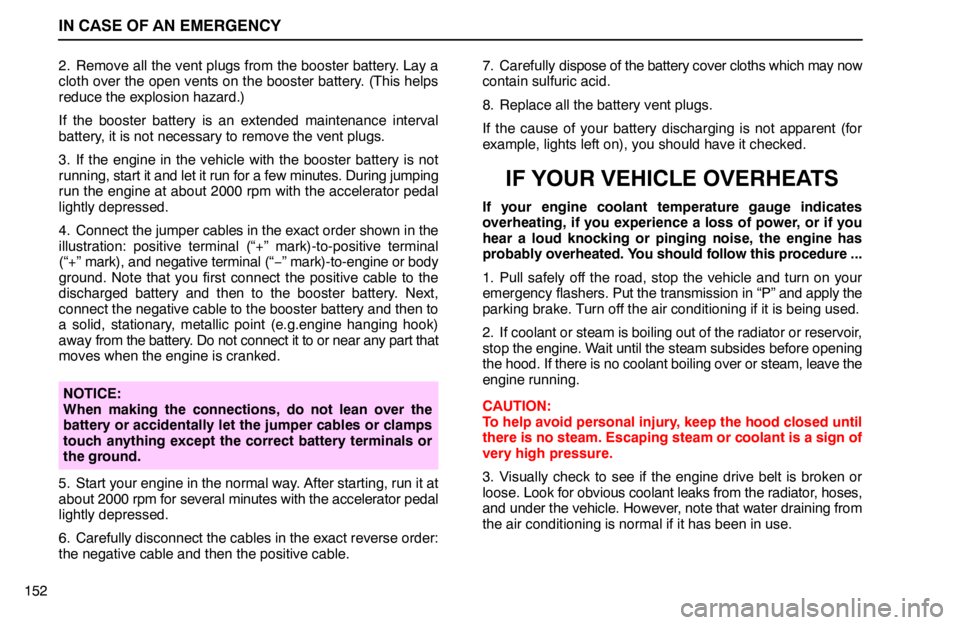engine overheat lexus LS400 1994 Gauges, Meters and Service Reminder Indicators / 1994 LS400: IN CASE OF AN EMERGENCY
[x] Cancel search | Manufacturer: LEXUS, Model Year: 1994, Model line: LS400, Model: Lexus LS400 1994Pages: 17, PDF Size: 6.78 MB
Page 1 of 17

SECTION 4
149
IN CASE OF AN EMERGENCY
If your engine stalls while driving150 . . . . . . . . . . . . . . . . . . . . . . . . . . .
If your vehicle will not start150 . . . . . . . . . . . . . . . . . . . . . . . . . . . . . . . .
If your vehicle overheats152 . . . . . . . . . . . . . . . . . . . . . . . . . . . . . . . . . .
If you have a flat tire153 . . . . . . . . . . . . . . . . . . . . . . . . . . . . . . . . . . . . . .
If your vehicle needs to be towed159 . . . . . . . . . . . . . . . . . . . . . . . . . .
If you cannot shift automatic transmission selector lever163 . . . . . . .
If the moon roof does not close164 . . . . . . . . . . . . . . . . . . . . . . . . . . . .
If you lose your keys or lock yourself out165 . . . . . . . . . . . . . . . . . . . .
Page 2 of 17

IN CASE OF AN EMERGENCY
150
IF YOUR ENGINE STALLS
WHILE DRIVING
If your engine stalls while driving ....
1. Reduce your speed gradually, keeping a straight line. Move
cautiously off the road to a safe place.
2. Turn on your emergency flashers.
3. Try starting the engine again.
If the engine will not start, see “If your vehicle will not start”.
CAUTION:
If the engine is not running, the power assist for the brakes
and steering will not work, so steering and braking will be
much harder than usual.
IF YOUR VEHICLE WILL NOT
START
(a) Simple checks
Before making these checks, make sure you have followed the
correct starting procedure instructions in “How to start the
engine” on page 121 and that you have sufficient fuel.
If the engine is not turning over or is turning over too
slowly —
1. Check that the battery terminals are tight and clean.
2. If the battery terminals are O.K., switch on the interior light.3. If the light is out, dim or goes out when the starter is cranked,
the battery is discharged. You may try jump starting. See “(c)
Jump starting” for further instructions.
If the light is O.K., but the engine still will not start, it needs
adjustment or repair. Call a Lexus dealer, Roadside Assistance
or Customer Service Assistance. (See “Foreword”.)
If the engine turns over at its normal speed but will not
start —
1. The engine may be flooded because of repeated cranking.
See “(b) Starting a flooded engine” for further instructions.
2. If the engine still will not start, it needs adjustment or repair.
Call a Lexus dealer, Roadside Assistance or Customer
Service Assistance. (See “Foreword”.)
(b) Starting a flooded engine
If the engine will not start, your engine may be flooded
because of repeated cranking.
If this happens, turn the key to “START” with the accelerator
pedal held down. Continue this operation for 15 seconds and
then stop cranking. Then try starting the engine.
If the engine does not start after 15 seconds of cranking,
release the key, wait a few minutes and try again.
If the engine still will not start, it needs adjustment or repair. Call
a Lexus dealer. Roadside Assistance or Customer Service
Assistance. (See “Foreword”.)
NOTICE:
Do not crank for more than 15 seconds at a time. This
may overheat the starter and wiring systems.
Page 4 of 17

IN CASE OF AN EMERGENCY
1522. Remove all the vent plugs from the booster battery. Lay a
cloth over the open vents on the booster battery. (This helps
reduce the explosion hazard.)
If the booster battery is an extended maintenance interval
battery, it is not necessary to remove the vent plugs.
3. If the engine in the vehicle with the booster battery is not
running, start it and let it run for a few minutes. During jumping
run the engine at about 2000 rpm with the accelerator pedal
lightly depressed.
4. Connect the jumper cables in the exact order shown in the
illustration: positive terminal (“+” mark)-to-positive terminal
(“+” mark), and negative terminal (“−” mark)-to-engine or body
ground. Note that you first connect the positive cable to the
discharged battery and then to the booster battery. Next,
connect the negative cable to the booster battery and then to
a solid, stationary, metallic point (e.g.engine hanging hook)
away from the battery. Do not connect it to or near any part that
moves when the engine is cranked.
NOTICE:
When making the connections, do not lean over the
battery or accidentally let the jumper cables or clamps
touch anything except the correct battery terminals or
the ground.
5. Start your engine in the normal way. After starting, run it at
about 2000 rpm for several minutes with the accelerator pedal
lightly depressed.
6. Carefully disconnect the cables in the exact reverse order:
the negative cable and then the positive cable.7. Carefully dispose of the battery cover cloths which may now
contain sulfuric acid.
8. Replace all the battery vent plugs.
If the cause of your battery discharging is not apparent (for
example, lights left on), you should have it checked.
IF YOUR VEHICLE OVERHEATS
If your engine coolant temperature gauge indicates
overheating, if you experience a loss of power, or if you
hear a loud knocking or pinging noise, the engine has
probably overheated. You should follow this procedure ...
1. Pull safely off the road, stop the vehicle and turn on your
emergency flashers. Put the transmission in “P” and apply the
parking brake. Turn off the air conditioning if it is being used.
2. If coolant or steam is boiling out of the radiator or reservoir,
stop the engine. Wait until the steam subsides before opening
the hood. If there is no coolant boiling over or steam, leave the
engine running.
CAUTION:
To help avoid personal injury, keep the hood closed until
there is no steam. Escaping steam or coolant is a sign of
very high pressure.
3. Visually check to see if the engine drive belt is broken or
loose. Look for obvious coolant leaks from the radiator, hoses,
and under the vehicle. However, note that water draining from
the air conditioning is normal if it has been in use.